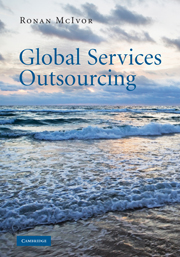Book contents
- Frontmatter
- Contents
- List of figures
- List of tables
- List of illustrations
- Acknowledgements
- 1 Introduction
- 2 Global services outsourcing overview
- 3 Making the services outsourcing decision
- 4 Location and sourcing model choice in global services outsourcing
- 5 Managing global services outsourcing arrangements
- 6 Creating shared services arrangements
- 7 Services outsourcing and performance management
- 8 Services outsourcing and the spin-off arrangement
- 9 Learning from failure and strategies for recovery in business process outsourcing
- 10 Conclusion
- Glossary
- Index
- References
3 - Making the services outsourcing decision
Published online by Cambridge University Press: 05 June 2012
- Frontmatter
- Contents
- List of figures
- List of tables
- List of illustrations
- Acknowledgements
- 1 Introduction
- 2 Global services outsourcing overview
- 3 Making the services outsourcing decision
- 4 Location and sourcing model choice in global services outsourcing
- 5 Managing global services outsourcing arrangements
- 6 Creating shared services arrangements
- 7 Services outsourcing and performance management
- 8 Services outsourcing and the spin-off arrangement
- 9 Learning from failure and strategies for recovery in business process outsourcing
- 10 Conclusion
- Glossary
- Index
- References
Summary
Introduction
Outsourcing has become a critical strategic decision that allows organisations to develop and leverage the capabilities required to compete in today's global business environment. Leading firms have been adopting more sophisticated outsourcing strategies, and have been outsourcing core processes such as design, engineering, customer service and marketing. These organisations have been benefiting greatly from accessing the specialist capabilities of vendors in a range of business processes. Leveraging the capabilities of more capable vendors allows organisations to outsource more critical business processes and enhance their own core capabilities that drive competitive advantage. However, many organisations are failing to capitalise on the opportunities offered by outsourcing, and often rush into outsourcing without fully understanding the complexities and risks. Selecting the most appropriate sourcing strategy encompasses a number of critical issues including the implications for competitive advantage, vendor capabilities, risks in the supply market and achieving a balance between the use of formal contracts and collaborative relationships.
This chapter presents a framework for identifying suitable outsourcing strategies for business processes. Integrating transaction cost economics (TCE) and the resource-based view (RBV), the framework provides a mechanism for understanding which processes should be kept internal and which should be outsourced, based on both organisational capability and opportunism considerations. The chapter is structured as follows. An overview of TCE and the RBV is presented, along with a rationale for integrating both theories into outsourcing decision-making.
- Type
- Chapter
- Information
- Global Services Outsourcing , pp. 45 - 78Publisher: Cambridge University PressPrint publication year: 2010



